Friday Jan 02, 2026
Friday Jan 02, 2026
Monday, 20 June 2016 00:08 - - {{hitsCtrl.values.hits}}
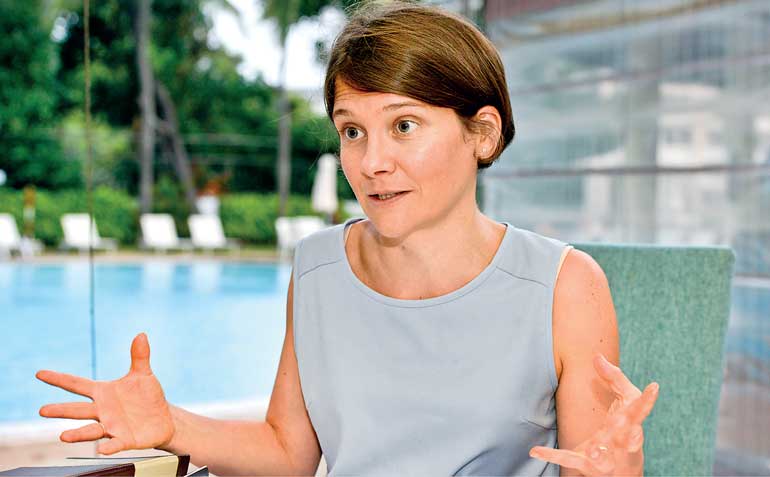
Moody’s Investors Service Sovereign Risk Group Senior Vice President Marie Diron - Pic by Daminda Harsha Perera
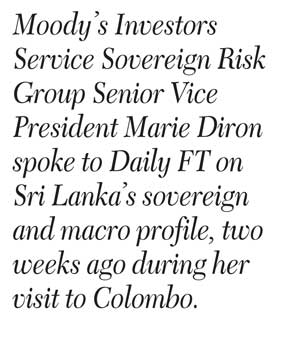
By Uditha Jayasinghe
Q: How do you find Sri Lanka’s broad economic situation?
A: Sri Lanka’s strengths and weaknesses have been there for some time and are coming to the fore more clearly. As far as the weaknesses are concerned from a sovereign rating perspective what we have been looking at are the fiscal issues. There is now an IMF program in place with ambitious objectives of raising revenues.
In our view, Sri Lanka’s weakness has been its revenues, which at 13% of GDP, is very low compared to other sovereigns. Raising that to 16% or 17% of GDP in the space of a few years will be challenging and will likely come at an economic cost to the taxpayer and even at a possible political cost. It remains to be seen if the Government can deliver on sustained fiscal consolidation, so our assumptions are more conservative. Yes there seems to be the willingness, the commitment to address the issues but the economic and political realities will mean that the outcomes may not match the stated goal.
There are also questions around external financing. External reserves have fallen to low levels, however you measure them. External debt needs to be repaid and that is the other side of the same coin. It reflects the high Government debt and some of that is financed externally. The IMF program will bring some relief, take a medium-term approach and for the IMF program relief to be sustained there needs to be progress on the fiscal side. The two really go together.
Q: What is the silver lining at this point?
A: The positive side has been the growth front and the potential for Sri Lanka. Growth has been robust throughout the conflict, which is a major achievement. It has come with major assets including an educated workforce and high levels of welfare as compared to 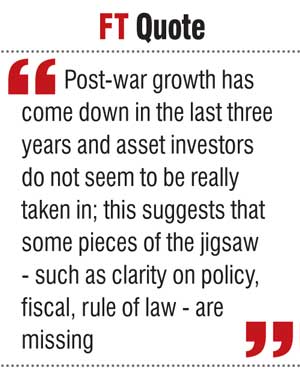 other countries in the region. Those positives can be tapped.
other countries in the region. Those positives can be tapped.
Interestingly, post-war growth has come down in the last three years and asset investors do not seem to be really taken in; this suggests that some pieces of the jigsaw - such as clarity on policy, fiscal, rule of law - are missing. Again, these are all medium-term projects and the Government requires time to change these issues.
Any economy will have a few difficult years ahead of it if the Government in power has limited policy room. So I think the big question is whether Sri Lanka’s potential can be unlocked in the current environment. Sri Lanka’s strategic position has always been there and whether this Government can deliver on it is yet to be found out.
Q: Taxes are a huge part of raising revenue. What is the best way the Government can go about this?
A: I think raising direct tax rates is not on the agenda and the focus seems more on indirect tax. There’s a lot of emphasis on broadening the indirect tax base, raising rates and removing numerous exemptions and improving administration. These are always worth trying but are not easy to accomplish.
Where the IMF and others come in is maybe finding a more balanced view where the Government does not put all its eggs in one basket. By having a more balanced tax structure the outcomes can be achieved and also tax collection is more resistant to cyclical developments. For 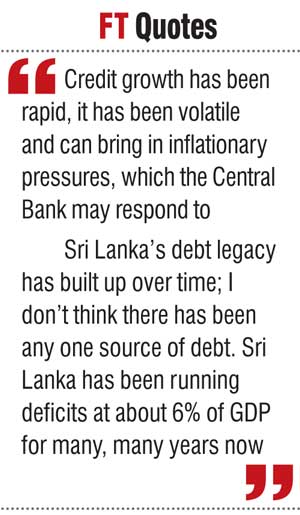 example, taxes such as VAT follow the growth cycle and could bring volatility to Government revenue. The other issue with VAT is that depending on how it’s structured, it can be regressive, hitting low income people and clearly there have been discussions in the Government about that. That is one of the reasons why we are more cautious in our estimations on what can be achieved because these changes are typically very difficult.
example, taxes such as VAT follow the growth cycle and could bring volatility to Government revenue. The other issue with VAT is that depending on how it’s structured, it can be regressive, hitting low income people and clearly there have been discussions in the Government about that. That is one of the reasons why we are more cautious in our estimations on what can be achieved because these changes are typically very difficult.
Q: As you have pointed out the Government’s revenue targets could be overambitious, so what should be plan B?
A: In our baseline projections what we think is most likely to happen is a lower increase in revenue. There does seem to be a commitment there and with the IMF discipline it will likely be that some of that will be achieved. The alternatives would partly depend on how much of a consensus there is on fiscal consolidation, above and beyond what the IMF demands.
The IMF brings in a focus but its powers are limited as it cannot legislate changes. I guess other revenue avenues could be tried. It seems that expenditure cuts are really the last resort; they are not on the table at all at the moment. Given the large public sector salary increases last year it would be very hard to do a political U-turn. So further pressure could come but Sri Lanka would still have to rely on market financing and will likely only rely on more taxes if such financing is not forthcoming.
Q: HSBC analysts recently said Sri Lanka’s equity market could grow as a result of the IMF program. What is your take on this?
A: When countries get an IMF program, it brings some relief and investors see liquidity coming in, perhaps as a low-cost form of financing if you want. This can potentially bring some investors back in. Sri Lanka does have growth potential and there would be interest for companies to come in. But they would need visibility on fiscal policies, infrastructure, the rule of law and establishing a track record on credibility and visibility takes a while.
Q: Should the Central Bank tighten monetary policy?
A: Historically, Sri Lanka’s monetary policy has tended towards easing budgetary financing at times, intervening in foreign exchange markets, and thereby preventing currency depreciation. With foreign currency debt accounting for around half of total government debt, a depreciation of the currency raises debt servicing costs.
As part of this IMF program, there is a move towards inflationary targeting so that would imply fewer exchange rate interventions; that could also require some monetary policy tightening. Credit growth has been rapid. It has been volatile and can bring in inflationary pressures, which the Central Bank may respond to.
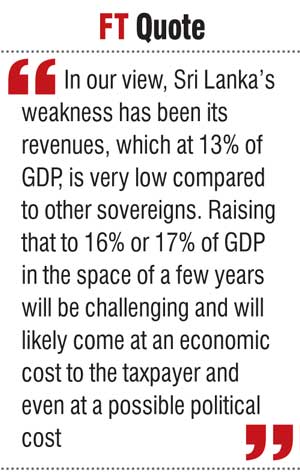 Q: How can the Government manage its debt burden so as not to put too much pressure on the consumer?
Q: How can the Government manage its debt burden so as not to put too much pressure on the consumer?
A: Sri Lanka’s debt is undoubtedly high (76% of GDP) when compared to other sovereigns. In the Government’s projections debt is coming down and will come down because of this fiscal consolidation. We are more cautious in our projections so we feel there is likely to be further increase in debt over the next couple of years before it starts to move back down.
Although some of this debt is financed through the IMF, World Bank and Asian Development Bank and other international institutions at a very low cost, the overall debt burden really restrains manoeuvring for the Government. If the external environment is harsh or foreign investment doesn’t flow in, the Government does not have room to implement some fiscal stimulus. It also means delivering on this fiscal consolidation for so many consecutive years is going to be challenging.
Q: When you said you expect debt to increase what levels are you projecting?
A: We are looking at a couple of percentage points; so towards 78% or 80%. It’s still lower than before as there were years when Sri Lanka’s debt percentage was above 100%. Compared to other sovereigns that have the same rating, Sri Lanka’s debt levels are high. The maturity of Sri Lankan growth is not particularly short, on average it is about six years, so there is not so much pressure from that.
Sri Lanka’s debt legacy has built up over time; I don’t think there has been any one source of debt. Sri Lanka has been running deficits at about 6% of GDP for many, many years now.
Q: Could the ratings change in a situation like this?
A: What could lead us to change the rating towards the downside is if we were to see this fiscal consolidation effort losing momentum or we were to see the liquidity pressures coming back in, possibly because fiscal metrics deteriorate. Even though there is IMF, World Bank and ADB funding, Sri Lanka still needs market access. The Government has not tried to access markets so far this year so we will have to see how that goes.
On the upside, we could see the fiscal consolidation working on a sustained basis. Our growth forecast is somewhat lower than the Government’s projections; about 4%-5% and if investment comes through then that could represent positive pressure on the ratings.
Q: How can the Government attract foreign investment?
A: Perceptions change very slowly. What investors want is, again, visibility, property rights, rule of law, low corruption. Basically they want to know they can operate their business in a predictable manner. Any progress in all these - which this can take years to create a track record - will be positive.
The key attraction of Sri Lanka is really its position. It has the capacity to serve India as a hub. But it is competing with others and that can be challenging. The Government is negotiating Free Trade Agreements with various parties and again that can be time consuming. The fact that foreign investment has not poured in post-war indicates that there is something missing and it could be in the good governance, rule of law and reform areas.
Q: What are the top three things the Government should focus on?
A: Fiscal consolidation is key, without that there is no way to establish stable external financing and if Sri Lanka continues to go through these cycles of high debt, liquidity pressures, then the growth potential will suffer. So that is a priority.
In the more medium term the reconciliation effort is again essential because, from a credit perspective, it is key to unleashing the full potential of the economy and that will not happen if part of the economy is not integrated into global markets and these underlying tensions continue. Constitutional reform is one step towards that but again these are very ambitious goals. Sri Lanka’s issues would be a lot for any Government and dealing with the spillover effects is difficult.
Q: Many experts have talked about Sri Lanka’s strategic position but despite being the fastest-growing economy in the world there is no indication that India’s growth would spinoff to the rest of the region as it did with China. In such a situation is Sri Lanka’s hub aspiration realistic?
A: The positive outlook on India’s Baa3 government rating reflects a gradual shift towards a policy framework that is more conducive to growth. Now we have monetary policy that is more credible so hopefully, low and stable inflation, along with reforms that are generally not wide ranging but where there is political opportunity for reforms they are going through.
India is also committed to fiscal consolidation and all that makes for very gradually improving environment that is more stable. As far as spillovers to the rest of the world is concerned, India is a massive market, so if it grows at about 7% then it will result in a growing middle class that will expand demand and some of that will be met by imports. But the model is very different to China. It is not an import intensive economy and the dynamics of it are different. Sri Lanka’s proximity to India can result in growth; the potential is there because it is essentially untapped. We are not seeing a 30% rise in imports year on year like we did with China but even if there is a 10% growth and Sri Lanka can get an increasing market share then that would be significant for Sri Lanka.
Hong Kong’s model was different and they did create their own manufacturing and financial industries, which may not happen on a large scale in Sri Lanka, but perhaps IT/BPO, other services and tourism can be a starting point.